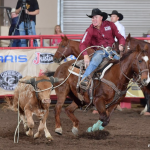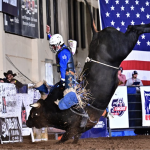Drilling Down on Beef Prices
Let’s drill down on beef prices. Here’s what we know. At the outset of the COVID pandemic in March 2020, all-fresh retail beef prices jumped significantly, running up about $1.40 per pound in just three months and peaking at about $7.40 per pound in June 2020. Beef prices then fell, but not as far as their pre-COVID level. Then, beginning at the end of 2020, beef prices trended sharply upward, and in August this year they reached over $9 per pound.
Boxed beef prices also jumped dramatically in March 2020 and peaked at an all-time high of more than $4 per pound in just two months. They then fell around mid-2020, only to dramatically jump again in early 2021, peaking later that year and then gradually falling toward autumn of 2022. Since fall 2022, boxed beef prices have trended sharply higher.
Fed cattle prices, however, fell while both boxed beef prices and retail beef prices were rising, and by mid-2020 they were at their lowest level in a decade, since July 2010. In 2019, as cattle prices were trending downward, the nation’s cowherd began liquidating. Over a year later, in mid-2020, a shock hit the U.S. cattle industry – a widespread drought that accelerated the decline of the already declining herd.
When cattle prices were at their low in July 2020, the spread between the price of cattle and boxed beef was about $1.08 per pound, and the spread between the price of cattle and the price of retail beef was about $5.80 per pound. Jump ahead five years. In July 2025, the spread between the price of cattle and the price of boxed beef increased to about $1.50 per pound, and the spread between the price of cattle and all-fresh retail beef prices was about $6.61 per pound.
What this tells us is that the spread between cattle prices and boxed beef prices increased $0.42 per pound, and the spread between cattle prices and retail beef prices increased $0.81 per pound. This means if the government believes beef prices should be lower, it should look not at the cattle industry but rather at the retail sector and the meatpacking sector, because they have captured more of the beef price increase than did the cattle producer.
If the spread between cattle prices and retail prices had not increased from its $5.80 per pound spread in July 2020, and if cattle prices remained as high as they were in July 2025, then the price of beef would have been about $8.09 per pound rather than $8.90 per pound.
What else do we know? We know that the available beef supply on a per capita basis was higher in 2024 than at any time since 2020, suggesting we do not have a beef shortage.
We also know domestic consumption has increased significantly during the past decade. In 2015, domestic production fell short of meeting domestic consumption by about 2.7 billion pounds, but in 2024 the shortfall had grown to 3.2 billion pounds. This tells us something very important – that domestic production has not kept pace with domestic consumption over the past decade.
So how is it that the available beef on a per capita basis was higher in 2024 if our domestic production – meaning beef produced from cattle born and raised in the U.S. – was not keeping pace with the long-term increase in domestic consumption?
Surprise! The answer is because we have become increasingly dependent on imports. In 2020, imports made up about 18% of domestic consumption, but in 2024 imports made up about 22% of domestic consumption. This tells us that America’s dependency on imports is growing, and that puts national security at risk.
And what of the claims that global beef packers are losing money as a result of higher cattle prices? My calculation, based on USDA data, is that for the one-year period from Nov. 11, 2024 to Nov. 10, 2025, the packer margin averaged about $230 per head per week. Compare this to the five-year period from Nov. 11, 2010 to Nov. 9, 2015, when the packer margin averaged about $188 per head per week.
Our problem is that we’ve reduced our nation’s ranchers and their herd size over the past few decades to the point where it cannot only not meet domestic food security needs; but also, it cannot withstand any form of economic shock without causing severe price anomalies for producers and consumers. We must look internally – within the borders of the United States – not externally to foreign countries, to resolve our domestic beef production shortfall.
Commentary by Bill Bullard, CEO, R-CALF USA


